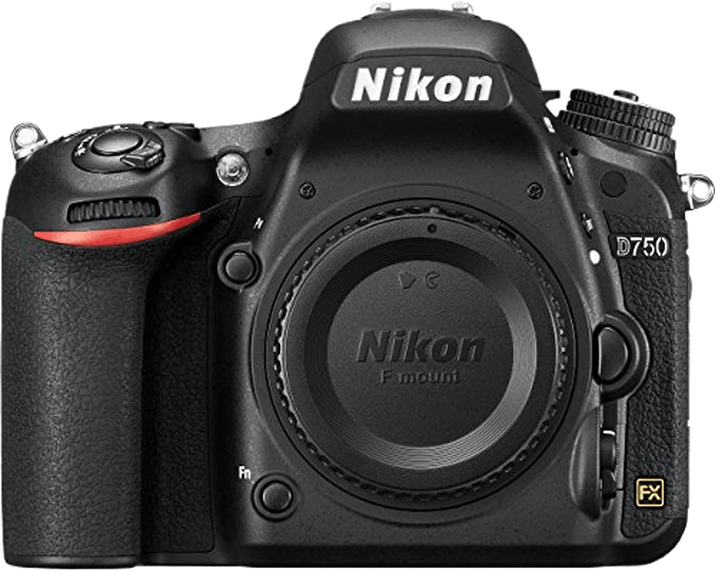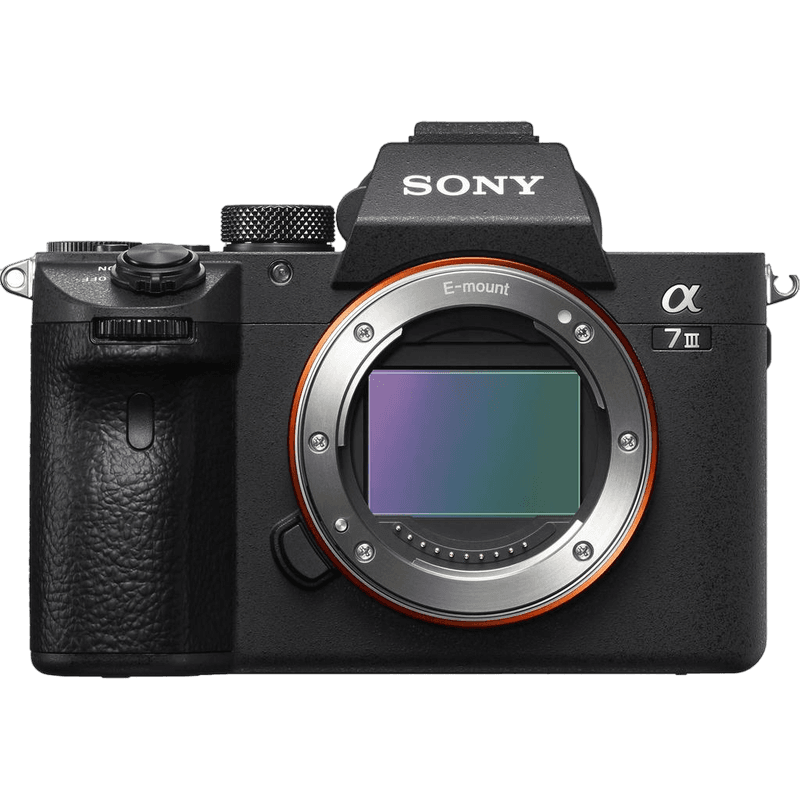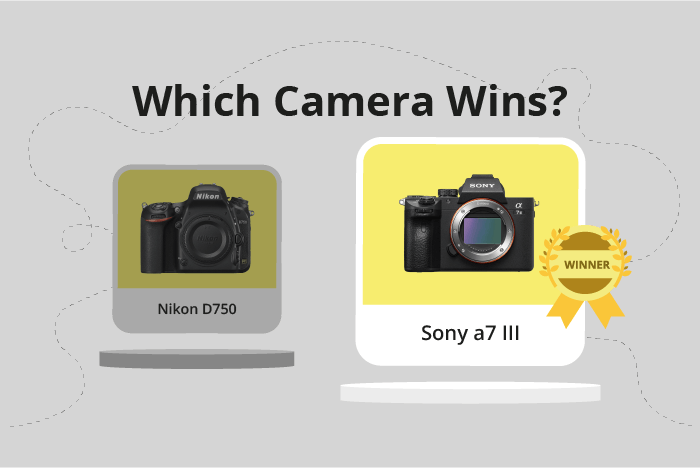Nikon D750 vs Sony a7 III Comparison
Nikon D750

Sony a7 III

The Sony a7 III outshines the Nikon D750 with a score of 80/100 compared to 68/100. Both cameras were released in different years, with the Nikon D750 in 2014 and the Sony a7 III in 2018. Although they share a similar launch price, the Sony a7 III is a mirrorless camera, while the Nikon D750 is a DSLR.
The Sony a7 III’s higher score reflects its advantages, such as a smaller and lighter body, measuring 127 x 96 x 74mm and weighing 650g. On the other hand, the Nikon D750, with dimensions of 141 x 113 x 78mm and a weight of 750g, may be preferred by some users who find the larger size more comfortable.
Despite the Nikon D750’s lower score, it remains a reliable camera with a strong following. However, the Sony a7 III’s superior score and features make it the better option for most photographers.
Nikon D750 vs Sony a7 III Overview and Optics
The Sony a7 III emerges as the winner in the optics comparison with a score of 81/100, while the Nikon D750 scores 71/100. Both cameras have certain optical specifications in common, such as 24-megapixel full-frame CMOS sensors, and their respective lens mounts – the Nikon F FX for the D750 and the Sony FE for the a7 III.
The Sony a7 III surpasses the Nikon D750 in several aspects. With a shooting speed of 10 frames per second (fps), the a7 III offers a faster continuous shooting rate compared to the D750’s 6.5 fps. Additionally, the a7 III has a higher DXOMARK sensor score of 96, compared to the D750’s score of 93, indicating better overall image quality. One significant advantage the a7 III has over the D750 is its built-in image stabilization, which helps reduce camera shake and blur in images.
The Nikon D750 has a few advantages over the Sony a7 III, such as a slightly higher megapixel count at 24.3 compared to the a7 III’s 24.2. The D750 also uses the Expeed 4 processor, while the a7 III utilizes the Bionz X processor. However, these minor differences do not significantly impact the overall optical performance.
Considering these factors, the Sony a7 III stands out as the superior choice in terms of optics, with its faster shooting speed, higher DXOMARK sensor score, and built-in image stabilization. While the Nikon D750 has its merits, the a7 III offers a more advanced and versatile optical performance, making it the better option for photographers seeking enhanced image quality and stability.
Nikon D750 vs Sony a7 III Video Performance
The Nikon D750 and the Sony a7 III both have a video score of 56 out of 100, making them equal in this aspect. They share some common specifications, such as not having built-in time-lapse functionality. However, there are differences in their video capabilities, which will be discussed below.
The Sony a7 III has a clear advantage in terms of video resolution, as it can record 4K videos with dimensions of 3840 x 2160. This means that the a7 III can capture more detail and provide higher quality footage compared to the Nikon D750, which has a maximum video resolution of Full HD (1920 x 1080). The higher resolution of the Sony a7 III makes it a better choice for those who prioritize video quality.
On the other hand, the Nikon D750 has a higher maximum video frame rate of 60fps, compared to the Sony a7 III’s 30fps. This allows the D750 to capture smoother motion, which can be particularly useful for recording fast-moving subjects or creating slow-motion footage. Therefore, the Nikon D750 may be more suitable for users who require higher frame rates for their video projects.
In comparing the video capabilities of the Nikon D750 and the Sony a7 III, it is evident that each camera has its strengths. The Sony a7 III offers superior video resolution with 4K capabilities, making it an ideal choice for those seeking high-quality footage. Meanwhile, the Nikon D750 provides a higher maximum frame rate, catering to users who need smooth motion capture. Ultimately, the choice between these two cameras will depend on the specific video requirements of the user.
Nikon D750 vs Sony a7 III Features and Benefits
The Sony a7 III surpasses the Nikon D750 in features, scoring 81/100 compared to the D750’s 59/100. Both cameras share some specifications, including a flip screen, WIFI connectivity, and the absence of GPS. However, the Sony a7 III outperforms the Nikon D750 in several aspects.
The Sony a7 III has a touchscreen, allowing for easier navigation and control, while the D750 does not. Additionally, the a7 III offers Bluetooth connectivity, enabling seamless connection with compatible devices for remote control and image transfer. The Nikon D750 lacks this feature.
The Nikon D750 does have some advantages, such as a larger screen size at 3.2 inches compared to the Sony a7 III’s 3-inch screen. The D750 also has a higher screen resolution of 1,229,000 dots, providing a clearer and sharper display than the a7 III’s 921,600 dots. However, these advantages do not outweigh the superior features of the Sony a7 III.
Considering the feature scores and specifications, the Sony a7 III is the superior camera in this comparison. Its touchscreen and Bluetooth capabilities provide users with more control and convenience, while the Nikon D750’s advantages in screen size and resolution are not significant enough to make it a better choice.
Nikon D750 vs Sony a7 III Storage and Battery
The Nikon D750 triumphs over the Sony a7 III in storage and battery, scoring 79/100 compared to Sony’s 68/100. Both cameras have two memory card slots and accept SD/SDHC/SDXC cards. However, the Sony a7 III also supports Memory Stick Duo/Pro Duo/Pro-HG Duo cards, giving it a slight edge in versatility.
Despite this advantage, the Nikon D750 outperforms the Sony a7 III in battery life, providing 1230 shots per charge with its EN-EL15 battery, while the Sony a7 III’s NP-FZ100 battery lasts for 750 shots. Neither camera offers USB charging.
The Nikon D750’s superior battery life makes it the better choice for photographers who require extended shooting sessions without frequent battery changes. On the other hand, the Sony a7 III’s additional memory card compatibility may appeal to those who prefer using Memory Stick cards.
Taking these factors into account, the Nikon D750 proves to be the stronger contender in storage and battery, while the Sony a7 III offers a minor advantage in memory card compatibility.
Nikon D750 vs Sony a7 III – Our Verdict
Are you still undecided about which camera is right for you? Have a look at these popular comparisons that feature the Nikon D750 or the Sony a7 III:

